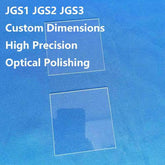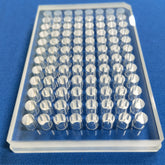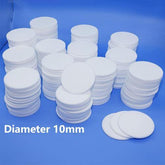Methods for eliminating the internal stress of sapphire glass
Sapphire glass has a wide range of applications, including use as a practical substrate material for GaN blue-green semiconductor diodes, as a material for high-power lasers, as an ideal window material, and as a laser matrix material. It can be manufactured using the temperature gradient method or the bubble method, such as 80 kg class, 120 kg class, 150 kg class.
During the process of sapphire crystal formation, stress is an inevitable occurrence within the crystal structure. In the case of sapphire crystal bars, additional processing stress is introduced subsequent to the bar digging process. This can result in issues such as large electric arc and low cutting accuracy when the sapphire crystal ingot with stress is cut. These problems may increase the stress on the crystal wafer during cutting process, resulting in greater warping and curvature of the wafer after cutting.

Furthermore, following conventional annealing treatment at approximately 1400 °C, the stress within the crystal wafer is unable to be released. Consequently, during the subsequent grinding and chamfering process of the wafer, there is an increased likelihood of issues such as collapsing, cracking, warping, and astigmatism, which in turn will result in a further reduction in yield. Therefore, in order to improve the yield of wafer processing, it is necessary to eliminate the internal stress in time. Furthermore, within a growth furnace utilizing a tungsten cage as a heating element, tungsten atoms (W) and a minimal quantity of molybdenum atoms (Mo) may randomly enter the melt via processes such as solid-state diffusion, penetration, and so forth.

The sapphire glass grown by the temperature gradient technique (TGT method) was subjected to a two-step annealing treatment in a high-temperature oxidizing atmosphere (1600°C air atmosphere) and a high-temperature reducing atmosphere (1900°C hydrogen atmosphere) for 120 hours. After stress relief and decolorization annealing, the sapphire crystal became colorless and transparent. Testing confirmed significant improvements in the integrity and optical transmittance of the sapphire.
However, it should be noted that the time cost and annealing process cost are higher when the two-step annealing method is used. The present invention pertains to a one-step high-temperature annealing process, namely direct high-temperature annealing in an air atmosphere at temperatures ranging from 1750 to 1800°C. The holding time is contingent on the crystal quality, with no duration exceeding 40 hours generally observed. The low-price impurity ions (e.g. Cr3, Ti3) contained within the sapphire raw material are subject to full oxidation to the high-price state (Cr4, Ti4), with the objective of further reducing the colour difference of the crystal rod and enhancing its quality.

Additionally, the oxidization of tungsten and molybdenum atoms to WO3 and MoO3 is observed, with these compounds being readily sublimed at high temperatures, thus departing from the crystal rod in the form of gas. High-temperature annealing is a suitable method for the removal of internal stress in crystals, with shorter annealing times at higher temperatures. In comparison with the existing two-step process, the annealing cycle of this one-step process is reduced in duration.
In this process, the sapphire glass was placed in a high-temperature annealing furnace, where it was heated according to a predefined temperature profile to 1750-1800℃, maintained at this temperature for approximately 40 hours, and then cooled to room temperature. This approach not only significantly shortened the annealing cycle but also reduced processing time and costs. The appearance of the sapphire fundamentally changed: before annealing, it appeared slightly cloudy and dark; after annealing, it became clear and transparent.






